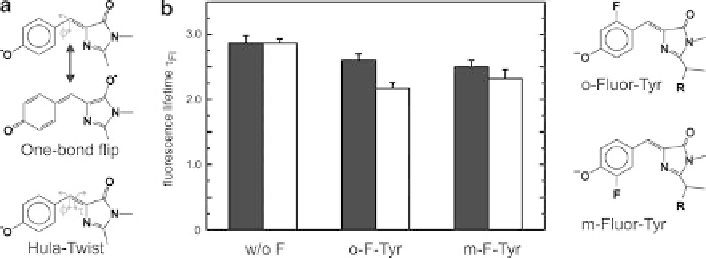Biology Reference
In-Depth Information
chromophore. In the meantime, many further natural sources of FPs are found but
fundamental work on these proteins is scarcely performed. We therefore focus on
avFP, which are derived from wild-type GFP from the pacific jellyfish
Aequorea
victoria
and where general tendencies are provided, but similar considerations
might also hold for the other proteins with identical chromophores. The common
feature of GFP and YFP is that fluorescence of both stems from anionic chromo-
phores, i.e., the phenolate form of Y66, and that is the reason why they are
discussed together.
3.3.1 B-State Versus I-State: Electronic Effects
Already the first thorough, spectroscopic investigations of wt-GFP shows that the
anionic chromophore R
consists of two different forms, i.e., the intermediate state
I and the stable ground state form B [
68
,
74
]. It is believed that the I-state, of which
the fluorescence is slightly red-shifted compared to that of the B-state, is formed
only after ESPT. Moreover, the higher thermodynamic stability of the B-state is
mainly attributed to a hydrogen-bonding between T203 and the chromophore,
which stabilizes the negative charge of the phenolate (see structure at the top in
Fig.
9a
). Later on, it was shown that a minor population of the I-state exists even
in the equilibrium with the neutral chromophore state and could be exclusively
populated by point mutations [
77
]. Pump-dump-probe spectra verify this finding
[
17
]. Independently, careful spectrally resolved lifetime measurements unravel two
lifetime components in wt-GFP as well as in eGFP: the faster component with
t
Fl
¼
2.7-2.8 ns is attributed to the predominant B-state whereas the second
Fig. 9 Electronic effects on the fluorescence lifetime. (a) The electronic structure is roughly
described by two mesomeric structures following the oxonol model [
75
]. The stronger the
benzoidal character (
top
) is the more effective is internal conversion via rotation around f. The
hula-twist is described by the simultaneous rotation around f and t and should be less susceptible
for preponderance of one mesomeric structure. (b) This phenomenon is also exemplified in the
comparison of fluorinated chromophores in eGFP (
black bars
) and eYFP (
white
) with their native
counterparts: The benzoidal character is enhanced upon fluorination leading to a reduced fluores-
cence lifetime t
Fl
. Structural effects might also play some role [
76
]

Search WWH ::

Custom Search